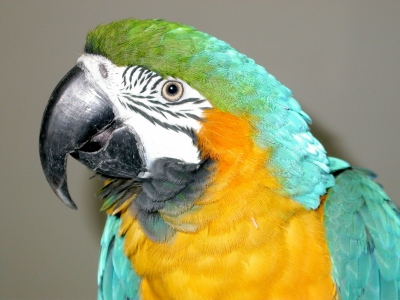
The boisterous blue and gold macaw is flying out of the spotlight today as June comes to an end. We hope you enjoyed following us @ExoticPetVets as we highlighted these big and beautiful birds in our exclusive Animal of the Month feature on Twitter. But we do have a summary of our tweets just in case you missed any. Did you know?:
- The blue and gold macaw (Ara ararauna) is a large parrot native to parts of Central and South America.
- Wild blue and gold macaws can be found in countries such as Ecuador, Panama, Colombia and Peru.
- Human activity (e.g. capture for the pet trade) has driven blue and gold macaws to extinction in Trinidad and Tobago.
- In the wild, blue and gold macaws live in lowland areas, including rainforests, swamps, wooded areas and savannas.
- Blue and gold macaws are among the larger macaws, with adults growing to a length of between 30 – 34 inches (76 – 86 cm).
- Blue and gold macaws are also commonly known as blue and yellow macaws.
- It’s no secret how blue and gold macaws got their name based on their colouring, which is primarily blue and gold/yellow.
- Both female and male blue and gold macaws have bright blue on their heads, upper necks, wings, tails and backs.
- Blue and gold macaws have yellow-gold plumage on their bellies and the undersides of their wings and tails.
- Blue and gold macaws also have a green forehead, a white face with fine stripes of black feathers and a black throat.
- Blue and gold macaws have a large black beak, which is perfect for crushing seeds and nuts.
- Blue and gold macaws have a joint between their upper beak and skull that allows their beaks more up and down movement.
- The extra movement allows blue and gold macaws to have more crushing power with their beaks.
- Blue and gold macaws can also use their beaks to help them climb.
- Blue and gold macaws are smart birds and will loudly squawk and scream to communicate.
- Loud squawking is part of blue and gold macaws’ natural behaviour. It cannot be trained away.
- Blue and gold macaws can talk and repeat easy words and short phrases.
- Blue and gold macaws are monogamous and usually mate for life.
- During breeding season, the female blue and gold macaw will incubate the eggs while the male brings food back to the nest.
- Blue and gold macaws typically breed during the first half of the year – January through July.
- As social birds, blue and gold macaws are often seen in the wild in pairs or groups of up to 30 birds.
- In captivity, blue and gold macaws need daily interaction with their caregivers and bird-safe toys to prevent boredom.
- Blue and gold macaws have a very long lifespan and can live more than 70 years with good care.

